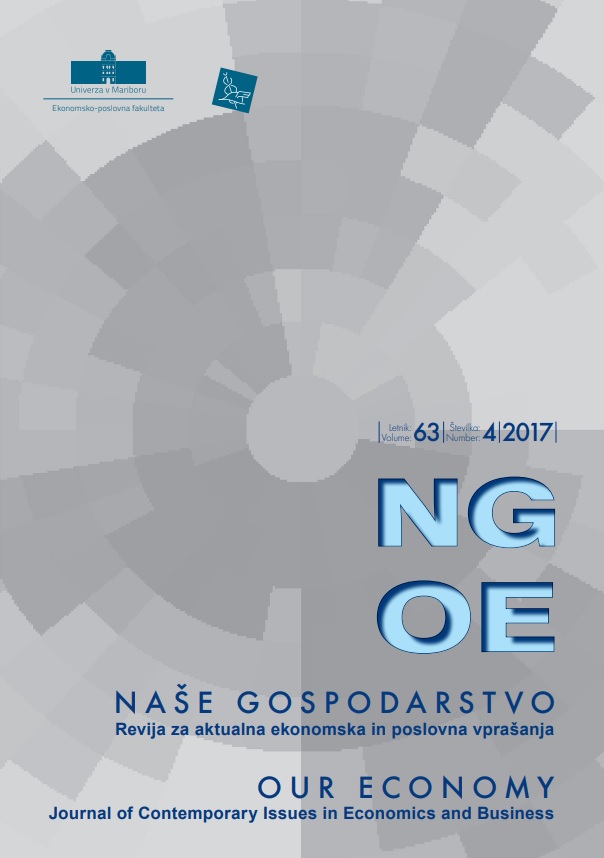Dimensions of Decision-Making Process Quality and Company Performance: A Study of Top Managers in Slovenia
Ključne besede:
kakovost procesa odločanja, racionalnost, motivacija, soudeležba, počrpanost informacij, menedžerjev trud, ustvarjalnost in inovativnost, deležniki podjetja, uspešnost podjetjaPovzetek
Prispevek obravnava odnos med dimenzijami kakovosti procesa odločanja in uspešnostjo podjetja za vodilne manedžerje v Sloveniji. Ugotovili smo, da podjetja, katerih vodilni manedžerji izkazujejo nadpovprečno veliko dimenzijo odprtega obzorja pri kakovosti procesa odločanja, imajo v povprečju višji delež prihodkov ustvarjenih na tujih trgih, kot pa podjetja, v katerih manedžerji izkazujejo podpovprečno odprto obzorje. Za menedžerje, ki delujejo v podjetjih, ki so prisotna na tujih trgih, smo lahko potrdili, da obstaja pri njih nizka/šibka povezava med dimenzijo vloženega truda pri kakovosti procesa odločanja in številom zaposlenih v podjetju.
Literatura
Amason, A.C. (1996). Distinguishing the effects of functional and dysfunctional conflict on strategic decision making: resolving a paradox for top management teams. The Academy of Management Journal, 39(1), 123 – 143. https://doi.org/10.2307/256633
Cabantous, L., & Gond, J.-P. (2011). Rational decision making as performance praxis: explaining Rationality’s Eternel Retour. Organization Science, 22(3), 573 – 586. https://doi.org/10.1287/orsc.1100.0534
Cankar, G. & Bajec, B. (2003). Effect size as a supplement to statistical significance testing. Horizons of Psychology, 12(2), 97 – 112. Cohen, J. (1988). Statistical Power Analysis for the Behavioral Sciences. Routledge, New York.
Cohen, J. (1992). A power primer. Psychological Bulletin. 112(1), 155–159. https://doi.org/10.1037/0033-2909.112.1.155
Carifio, J. Perla, R.J. (2007). Ten common misunderstandings, misconceptions, persistent myths and urban legends about Likert scales and Likert response formats and their antidotes, Journal of Social Sciences, 3(3), 106-116. https://doi.org/10.3844/jssp.2007.106.116
Colvin, C. (1997). The most valuable quality in a manager. Fortune, 29 December, 179 – 280.
Cornish, R. (2007). Statistics: 3.1 Cluster Analysis. Mathematics Learning Support Centre. Retrieved from http://www.statstutor.ac.uk/resources/uploaded/clusteranalysis.pdf.
Dean, J.W., and Sharfman, M.P. (1996). Does decision process matter? A study of strategic decision making process. Academy of Management Journal, 39(2), 368 – 396. https://doi.org/10.2307/256784
Driver, M.J., Brousseau, K.R., & Hunsaker, P.L. (1990). The Dynamic Decision Maker: Five Decision Styles for Executive and Business Success. Harper & Row, New York.
Ducker, P.F. (1967). The effective decision. Harvard Business review, 45(January – February) 92 – 98.
Eisenhardt, K.M. (1989). Making fast strategic decisions in high velocity environments. Academy of Management Journal, 32(3), 543 – 576. https://doi.org/10.2307/256434
Gilmore, A. (1998). Quality in management decision making within a changing context. Journal of Management Development, 17(2), 106 –120. https://doi.org/10.1108/02621719810206014
Guillemette, M.G., Laroche, M., and Cadieux, J. (2014). Defining decision making process performance: conceptualization and validation of an index. Information & Management, 51, 618 – 626. https://doi.org/10.1016/j.im.2014.05.012
Harrison, F.E., & Pelletier, M.A. (2000). The essence of management decision’. Management Decision, 38(7), 462 – 469. https://doi.org/10.1108/00251740010373476
Kelley, K. & Preacher, K.J. (2012). On Effect Size. Psychological Methods. 17 (2), 137–152. https://doi.org/10.1037/a0028086
Klingebiel, R., and Meyer, A.D. (2012). Becoming aware of the unknown: decision making during the implementation of a strategic initiative. Organization Science, 24(1), 133 – 153. https://doi.org/10.1287/orsc.1110.0726
Jackson, T. (1991). Measuring Management Performance. A Development Approach for Trainers and Consultants. Kogan Page, London.
Malaska, P., & Holstius, K. (1999). Visionary management, The journal of futures studies, strategic thinking and policy, 1(4), 353 – 361.
Malakooti, B. (2010). Decision making process: typology, intelligence and optimization. Journal of Inteligent Manufacturing, 23(3), 733 –746. https://doi.org/10.1007/s10845-010-0424-1
McLaughlin, D.I. (1995). Strengthening executive decision making. Human Resource Management, 34(3), 443 – 461. https://doi.org/10.1002/hrm.3930340307
Rausch, E., & Anderson, C. (2011). Enhancing decisions with criteria for quality. Management Decision, 49(5), 722 – 733. https://doi.org/10.1108/00251741111130814
Sawilowsky, S. (2009). New effect size rules of thumb. Journal of Modern Applied Statistical Methods, 8(2), 467–474. https://doi.org/10.22237/jmasm/1257035100
Schwenk, C. (1995). Strategic Decision Making. Journal of Management. 21(3), 471 – 493. https://doi.org/10.1177/014920639502100304
Wagner-Mainardes, E., Alves, H., & Raposo, M. (2012). A model for stakeholder classification and stakeholder relationships, Management Decision, 50(10), 1861 – 1879. https://doi.org/10.1108/00251741211279648
Xi, R., & Wunsch II, D.C. (2008). Recent advances in cluster analysis. International Journal of Intelligent Computing and Cybernetics, 1(4), 484 – 508. https://doi.org/10.1108/17563780810919087
Ying-Chieh, C., Shui-Chuan, C., & Ying-Hao, C. (2013). Decision quality by the loss cost of Type I and Type II errors. The TQM Journal, 25(2), 202 – 220. https://doi.org/10.1108/17542731311299627
